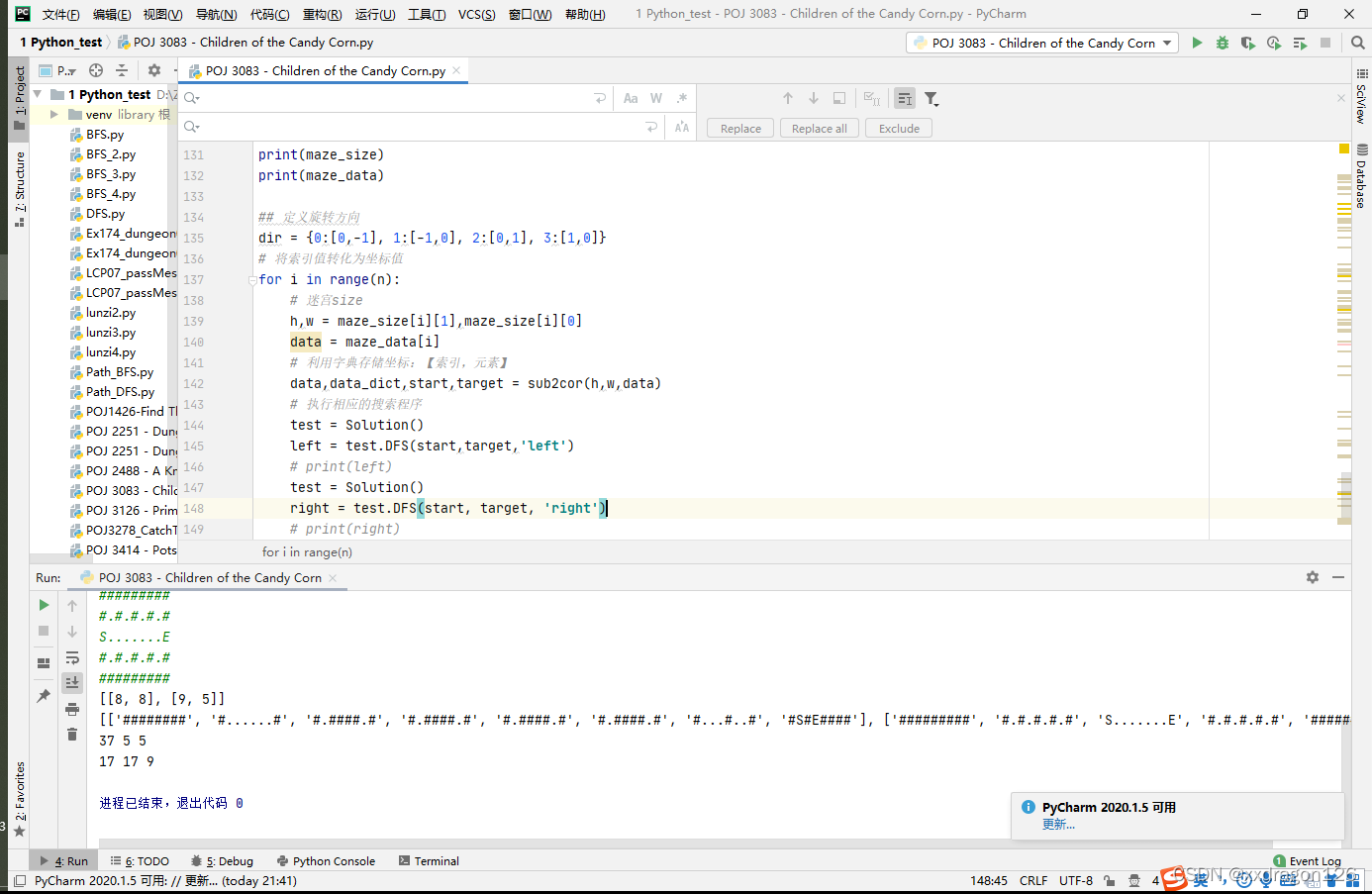一 原题及参考资料 # 英文:https://www.cnblogs.com/lovychen/p/3879044.html # 中文:https://exp-blog.com/algorithm/poj/poj3083-children-of-the-candy-corn/ # https://blog.csdn.net/lyy289065406/article/details/6647668 # https://blog.csdn.net/weixin_44689154/article/details/99731192
特别注意:左转、右转时,face的更新方式不同。
二?代码
# 万圣节——玉米地迷宫
# 英文:https://www.cnblogs.com/lovychen/p/3879044.html
# 中文:https://exp-blog.com/algorithm/poj/poj3083-children-of-the-candy-corn/
# https://blog.csdn.net/lyy289065406/article/details/6647668
# https://blog.csdn.net/weixin_44689154/article/details/99731192
import collections
## 索引转坐标
def sub2cor(h,w,data):
data_dict = collections.defaultdict(list)
temp = []
count = 0
for i in range(h):
for j in range(w):
temp.append(data[i][j])
data_dict[str(i)+";"+str(j)] = [count,data[i][j]]
count += 1
# 查找初始节点和目标节点
if data[i][j] == "S":
s = str(i)+";"+str(j);
if data[i][j] == "E":
target = str(i)+";"+str(j);
# print(data_dict)
return temp,data_dict,s,target
##
class Solution:
def DFS(self,s,target,way):
self.keys = data_dict.keys()
self.steps = 0
self.dfs(s,0,way,1)
return self.steps
def dfs(self,s,face,way,step):
# 判断是否到达目标点
if s == target:
#
self.steps = step
# print(step)
# return self.steps
return
# 由当前方向确定下一个方向
# 分左右进行判断
if way == 'left':
nextFace = (face+3)%4
elif way == 'right':
nextFace = (face+1)%4
for i in range(4):
hh,ww = map(int,s.split(';'))
new_hh = hh + dir[nextFace][0]
new_ww = ww + dir[nextFace][1]
if (str(new_hh)+";"+str(new_ww)) not in self.keys or data_dict[str(new_hh)+";"+str(new_ww)][1]=='#':
# 转移方向
if way == 'left':
face += 1 #千万注意啊,走不通时,往前走
nextFace = (face + 3) % 4
elif way == 'right':
face -= 1 #千万注意啊,走不通时,往后退
nextFace = (face + 1) % 4
continue
if (str(new_hh)+";"+str(new_ww)) in self.keys and data_dict[str(new_hh)+";"+str(new_ww)][1] !='#':
# if data_dict[str(new_hh) + ";" + str(new_ww)][1] != '#':
face = nextFace;
self.dfs(str(new_hh)+";"+str(new_ww),face,way,step+1)
break
return
## 最短路径bfs
def numOFpath(target,parent):
V = target
step = 0
while V!=None:
V = parent[V]
step += 1
return step-1
def bfs(s, target):
if s == target:
return 0
# 将起始节点加入到列表中
queue = []
queue.append(s)
# 设置已访问的节点
visited = set()
visited.add(s)
# 设置父节点
parent = {s:None}
# 键值节点
keys = data_dict.keys()
# 循环处理
while len(queue) >0:
# 弹出节点
vertex = queue.pop(0)
visited.add(vertex)
# 查找邻接点
nodes = []
hh, ww = map(int, vertex.split(';'))
str1 = str(hh+1) + ";" + str(ww)
str2 = str(hh-1) + ";" + str(ww)
str3 = str(hh) + ";" + str(ww+1)
str4 = str(hh) + ";" + str(ww-1)
nodes.append(str1)
nodes.append(str2)
nodes.append(str3)
nodes.append(str4)
for i in nodes:
if i in keys:
if i not in visited and data_dict[i][1] !='#':
queue.append(i)
# visited.add(i)
parent[i] = vertex
if i == target:
return numOFpath(target,parent)+1
return -1
## 关于输入
n = int(input().strip()) #共n个迷宫
maze_size = [] #存储迷宫大小
maze_data = []
for i in range(n):
# 第i组迷宫
w,h = map(int,input().strip().split(' ')) #获取迷宫的宽度和高度
maze_size.append([w,h])
# 接下来,存储这些数据
temp = []
for j in range(h):
temp.append(input().strip())
maze_data.append(temp)
print(maze_size)
print(maze_data)
## 定义旋转方向
dir = {0:[0,-1], 1:[-1,0], 2:[0,1], 3:[1,0]}
# 将索引值转化为坐标值
for i in range(n):
# 迷宫size
h,w = maze_size[i][1],maze_size[i][0]
data = maze_data[i]
# 利用字典存储坐标:【索引,元素】
data,data_dict,start,target = sub2cor(h,w,data)
# 执行相应的搜索程序
test = Solution()
left = test.DFS(start,target,'left')
# print(left)
test = Solution()
right = test.DFS(start, target, 'right')
# print(right)
ans = bfs(start,target)
print(left,right,ans)
输入:
2
8 8
########
#......#
#.####.#
#.####.#
#.####.#
#.####.#
#...#..#
#S#E####
9 5
#########
#.#.#.#.#
S.......E
#.#.#.#.#
#########输出:
37 5 5
17 17 9
?